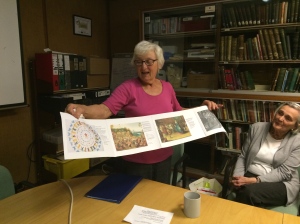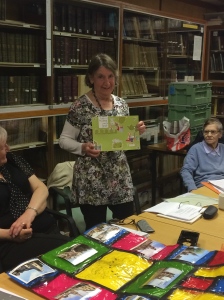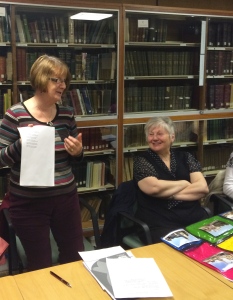It was undoubtedly an ambitious task to cover a history of England in a six week WEA class, but by focussing on themes and selecting images and text the recent ‘A History of England – Words and Pictures’ course did indeed achieve this goal. The course included how Roman mosaics reflected changing society and beliefs, the influence of religion in key Anglo Saxon texts, the representation of conflict in the Bayeux Tapestry, issues of democracy through the Magna Carta, vivid agricultural scenes in the Luttrell Psalter, Tudor Portraiture, the turbulent seventeenth century, Pepys’ Diary, Daniel Defoe’s accounts of different places, Victorian innovation and representations of conflict in the twentieth century and emotional responses to the poetry and art of the world wars.
However, it was the collaborative and very much creative endeavours of the group that really made the course. Drawing upon the many inspirations of how words and pictures have been used to record historic events, describe everyday life and campaign for change from throughout the course, students embarked upon a project to document daily life in the twenty-first century.
Here is a selection of their work:-
Ruth showcases her pictorial story of the history of dance through images – dance is an important part of her life and her design was inspired by the Bayeux Tapestry we had looked at in an earlier session.
Pauline reflected on her family history and said “The world has always needed leaders, inventors, entrepreneurs, people of power, but try to imagine life without the ordinary man or woman going about their daily business, working, farming, fighting wars, paying taxes. There would be no goods to trade, not much food, no army to defend the country, no transport no mills or factories, no offices, no schools, teachers or colleges – the list is endless. The unknown, unsung masses are what made the world what it is today, and also put the Great in Great Britain”
Joan explained how she had started a personal discovery of the Halifax area and as she travelled she thought of writing about what she saw but in the end opted for a visual representation of an important hobby – gardening
An extract from a letter to Daniel Defoe by Jonathan:-
“Dear Daniel Defoe,
It is now 290 years since your visit to Halifax in 1725. I enjoyed reading your account of your journey here in ‘A Tour Through the Whole Island of Great Britain’. I thought you would be interested to know something of the changes that have taken place since your visit.
You described your journey here on the main packhorse route from Wakefield as being ‘exceedingly troublesome and dangerous’. The road was ‘so steep, so rugged…sometimes too slippery’ and hardly suitable for carriages. The route was replaced by new turnpike roads in 1741 and 1824. Then in 1841 there was a development you would have found exciting. The Manchester and Leeds Railway Company opened a railway line through the Calder Valley. Naturally, the Rochdale and Halifax Turnpike Trust tried to delay proceedings…in recent years there has been a development that I think you would find even more astonishing. A broad road has been constructed with room for three carriages to travel abreast in each direction. This road crosses the old packhorse route near Hipperholme. Today the carriages are referred to as ‘cars’ and are powered by internal combustion engines using refined oil. They can maintain a speed of 70 mph. The average daily flow of cars on this road is 1000,000 travelling east and 78,000 travelling west!”
The letter continues to describe changes to religion and governance and finally publishing discussing e-books. It concludes “I think it would please you to know that many of your writings are still in print. It is possible to buy an ebook at a cost of £1-6s-6d with your Complete Works (illustrated)”.
My journey to Walsingham by Margaret described it as a “marvellous place of peace and quiet, able to concentrate on important parts of our lives away from every day things we normally do”.
Sue wrote a poem entitled ‘My Favourite Things’
“Give way to drivers – they look miserable
Not a wave to me – am I invisible?
Shop assistants – I’m ignored
They just stand chatting looking bored
Litter from cars lands with a bump
Turning our village into a dump
Junk emails – nuisance calls
Cause me to bounce off all four walls
Can’t climb trees can’t play conkers
Health and safety drives me bonkers
Please forgive me I’m only human
Or am I just a grumpy old woman”
Congratulations to everyone who contributed this work to add new words and pictures to document some aspect of their lives – great innovative work.



